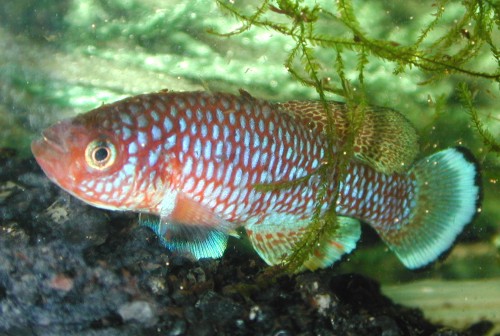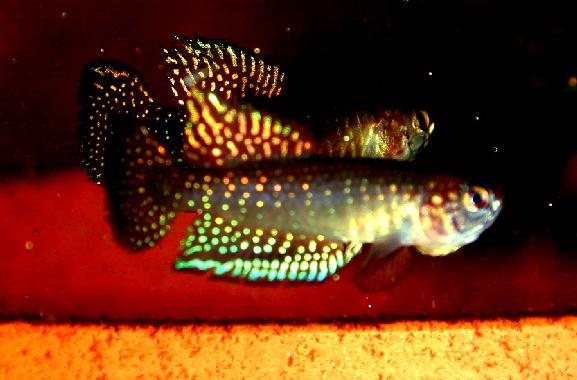 |
| N. foerschi, photo by Neil Armstrong, Australia |
 |
| N. foerschi, photo by Neil Armstrong, Australia |
Annual killifish are, in my opinion, easier to maintain than non-annual killifish. With annual killifish you know they will not live very long and unless you put effort into breeding them now you may not get another chance. Because you begin with this mentality you are far more likely to have a successful result. The basics to keeping annual killifish can be found in the article Nothobranchius an introduction (NAKAJ 2(4):4--8 (2000)) that is available here as 41 Kb PDF.
 |
| N. kafuensis "Kayuni ZAM 97/1", photo by Bill Shenefeldt. |
Nothos aren't the only annual killifish. The continent of South America abounds with annual killifish. More information regarding these fish can be found on the SAA homepage. (SAA = South American Annual)
All annual fish relish live and frozen foods. Dried foods are an excellent supplement where ever they are accepted but to meet the metabolic needs of these fish a high lipid/protein food is needed. Nothos fare well on frozen beef heart (with added garlic). Even wild fish will take this food. In general feeding beef heart is not a good idea as the animal fat isn't metabolized well and settles around the internal organs where it can cause health problems. With most annual fish this is irrelevant as the fish are not going to live very long in any case. On the other hand, many of the SAAs don't tolerate beef heart at all. They quickly develop dopsy and die. For them a diet of aquatic arthropods is best.
 |
| N. rachovii "Beira 98", photo by Bob Morenski. This is not a difficult fish to keep and breed but requires some experiance. |
Exceptions are the fish of the genus Gnatholebias and Moema. These are big active fish that thrive at high temperatures and do excellently on beef heart.
In general the annual killifish are tolerant of a wide range of temperatures. There are exceptions... The Gnatholebais do best only above 24°C while the Austrolebias only do well below this temperature. N. foerschi can tolerate temperatures from 16 to 30°C.
 |
| Simpsonichthys whitei, photo by Bill Shenefeldt. |
Annuals are normally equally tolerant of water quality but again there are exceptions. Most Nothos become very sensitive to velvet in soft acidic water while Leptolebias do not do well at all in hard alkaline water. In fact, Leptolebais are so sensitive that they can't tolerate even minor changes in water quality that occur with water changes.
Some good beginners annuals are Austrolebias nigripinnis, Nothobranchius. foerschi, N. guentheri, N. korthausae, N. palmqvisti, Simpsonichtys constanceae and S. whitei. There are many more fish suitable for beginners but these are the most popular and commonly available and attractive.
Last updated 1 July 2004